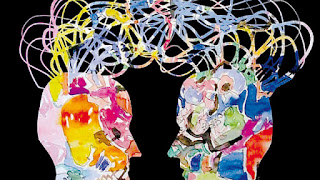Neuroscience and Art
Neuroscience is a huge part of the curriculum in my studies as a psychology major. Neuroscience is more focused on the nervous system and the brain, whereas psychology is more focused on specific behaviors that can have unconventional and sometimes even predictable affects on the brain. Concepts such as perception and interpretation play a major role in both psychology and neuroscience. These complex inner workings of the mind are perfectly bound together in a flawless artistic manner.
Brain waves
http://psychandneuro.duke.edu/uploads/media_items/imgcog-neuro1.960.360.c.jpg
I personally could not agree more on the fact that the human brain is the most powerful organ in the body. And this, in many ways, not only allows human beings to witness and understand art, but in many forms this understanding is an art. I personally found this to be very interesting so i did some further research on it. The question that struck me with this research was why do humans find the works of Van Gogh, Picasso, and Dali so intriguingly beautiful. Questions like how did Pablo Picasso's "Les Femmes d'Alger (Version O)" sell for more than 179 million dollars struck me very strongly.
Pablo Picasso's "Les Femmes d'Alger (Version O)"
<http://www.artnet.com/magazine_pre2000/features/decker/decker11-4-9.asp>
Upon further research I found that our minds know exactly when and if there's a clear representation of familiar aspects of everyday life. This allows us to relate ourselves on a deeper level with art and even allow us to interpreting meanings from the arbitrary. Our brains are also designed to scan and look for human like qualities in art. Take a painting for example, the brain scans it within seconds and tries to find faces even out of discrete patches of color and this can trigger emotional responses. These findings- although surprising- allowed me to understand this unique relationship between the mind and art more respectively.
Human mind making facial recognition from art
http://tarnoffartcenter.org/the-ams-community-gallery/brain-art-exchanges-discussions-and-art-critiques/
Sources:
Vesna, Victoria. "Neuroscience pt1. "UC online. YouTube, 17 May. 2012. Web. 15 May. 2016.
Vesna, Victoria. "Neuroscience pt2. "UC online. YouTube, 17 May. 2012. Web. 15 May. 2016.
Vesna, Victoria. "Neuroscience pt3. "UC online. YouTube, 17 May. 2012. Web. 15 May. 2016.
Landau, Elizabeth. "What the brain draws from: Art and neuroscience." CNN., 15 Sep 2012. Web. 15 May. 2016.
Miles, Kathleen. "How Art Is Crucial To Understanding The Human Mind." Huffpost . Web. 15 May. 2016.



I thought that your post was compelling because of the way you personalized the concept to something that struck your curiosity. The research you found about what our minds process when it looks at art is definitely something to think about. I feel like it makes sense that our minds try to demystify the art by finding familiar pieces in it, which in turn, makes the art just that more interesting to look at. In a way, one can argue that art can't be truly an art if a person does not see it in such a way. However, I do feel like we can almost find art in most everything we stumble upon and this has never been true, especially after this class. It's like our brain is wired to find some artistic quality in an object which makes it an art. It is truly no wonder how much we appreciate the paintings of great artists such as Van Gogh. Our minds can look at these beautiful paintings and find something unique in them every time.
ReplyDelete